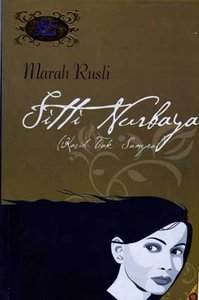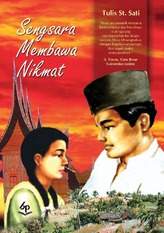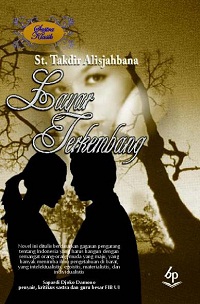Plot
Rasmani and Masrul are childhood friends from Bukittinggi, West Sumatra. Unknown to Masrul, Rasmani has fallen in love with him and, when he moves to Painan to work, she feels her heart torn asunder. Several days later Rasmani receives a letter from him, in which Masrul tells her he is betrothed to his cousin Aminah, a betrothal with which he disagrees. Masrul has realised that he loves Rasmani, but he feels obliged to marry his cousin. Rasmani, meanwhile, becomes a teacher.
While working Masrul meets a rich school principal, who asks Masrul to marry his daughter Muslina. When Masrul, after constant nagging, finally accepts, his family and Rasmani are devastated. Although Masrul and Muslina move to Padang and have a child together, their marriage is not a happy one, and eventually Masrul begins to drink excessively and rarely comes home. Feeling unappreciated, he finally chooses to divorce Muslina and return to Bukittinggi, despite Rasmani urging him not to do so.
After meeting Rasmani again, Masrul tells her that he loves her and the two plan to marry. However, before marriage Masrul insists that he must save more money, and he goes to Medan to work over Rasmani's protests. While there he is out of contact for several months, leading Rasmani to worry and fall ill. After receiving a letter that Masrul has found a job and will be coming to meet her, she is shocked. Her weak heart stops and she dies, just before Masrul can return to Bukittinggi.
Themes and styles
The Indonesian literary critic Zuber Usman contrasts Kalau Tak Untung with the earlier novel Sitti Nurbaya (1923) by Marah Rusli. He notes that both begin in a similar fashion and have the same general pattern, but, unlike Sitti Nurbaya with its background in Minang nobility, Pengaruh Keadaan portrays simple villagers without noble blood. Taking a feminist approach, Haninah suggests the novel is an antithesis to anti-forced marriage works like Sitti Nurbaya and Merari Siregar's Azab dan Sengsara (Pain and Suffering; 1920): she writes that the novel, as opposed to the earlier works, emphasises that marrying for love does not ensure happiness.
The Dutch scholar of Indonesian literature A. Teeuw notes that Kalau Tak Untung shared many themes with contemporary novels, including the traditional Sumatran background; however, the common theme of intergenerational conflict is not present. He suggests that, unlike in novels by male writers, the main character of Masrul is weak and indecisive. The writer Juliette Koning also suggests that the novel has an implication of "male weakness, selfishness, and insensitivity". She notes, however, that readings of Kalau Tak Untung have generally focused on the "inexorable fate" which humans face, that "the course of human life is determined by fortune".
The Japanese scholar of Indonesian literature Tsuyoshi Kato notes the presence of a non-traditional material culture in Kalau Tak Untung, exemplified by the protagonists' "enthusiastic" use of letters as a means of communication. He notes that the novel's original cover likewise expounded the role of letters in the narrative. He suggests that letters are the reason the love of geographically separated protagonists can be told. He further notes that the story is representative of a new "social map", in which traditional structures are subjugated to colonial ones of time and bureaucracy.
A large portion of the text consists of dialogue and letters between Masrul and Rasmani, which center around topics related to marriage and custom. What description is used in the text, according to Koning, is meant to be complementary to internal monologues and thoughts of the characters. She considers the style "graceful [and] flowing" until the end of the novel, when Masrul resorts to using "tortured, fragmented phrases" to apologise to the dead Rasmani.

Indonesian literature is a term grouping various genres of South-East Asian literature.

Marah Roesli was an Indonesian writer.

Azab dan Sengsara is a 1920 novel written by Merari Siregar and published by Balai Pustaka, Indonesia's major publisher at that time. It tells the story of two lovers, Amiruddin and Mariamin, who are unable to marry and eventually become miserable. It is generally considered the first modern Indonesian novel.

Sitti Nurbaya: Kasih Tak Sampai is an Indonesian novel by Marah Rusli. It was published by Balai Pustaka, the state-owned publisher and literary bureau of the Dutch East Indies, in 1922. The author was influenced by the cultures of the west Sumatran Minangkabau and the Dutch colonials, who had controlled Indonesia in various forms since the 17th century. Another influence may have been a negative experience within the author's family; after he had chosen a Sundanese woman to be his wife, Rusli's family brought him back to Padang and forced him to marry a Minangkabau woman chosen for him.

Sengsara Membawa Nikmat is an Indonesian novel written by Tulis Sutan Sati. It was published in 1929 by Balai Pustaka. It tells the story of Midun, the son of a farmer, who experiences many trials before finally living happily with his new wife. It has been noted as one of Sati's most interesting works.

Layar Terkembang is an Indonesian novel by Sutan Takdir Alisjahbana. Published in 1936 or 1937 by Balai Pustaka, it tells the story of two sisters and their relationship with a medical student. It has been noted as emphasizing the need for Indonesians to adopt Western values in order to modernize the country.

Belenggoe is a novel by Indonesian author Armijn Pane. The novel follows the love triangle between a doctor, his wife, and his childhood friend, which eventually causes each of the three characters to lose the ones they love. Originally published by the literary magazine Poedjangga Baroe in three instalments from April to June 1940, it was the magazine's only published novel. It was also the first Indonesian psychological novel.

Atheis is a 1949 Indonesian novel written by Achdiat Karta Mihardja and published by Balai Pustaka. The novel, using three narrative voices, details the rise and fall of Hasan, a young Muslim who is raised to be religious but winds up doubting his faith after dealings with his Marxist–Leninist childhood friend and an anarcho-nihilist writer.
Andries Teeuw, better known as A. Teeuw in scholarly circles and Hans Teeuw to his friends, was a Dutch critic of Indonesian literature.
Darah Muda is a 1927 novel written by Indonesian writer Djamaluddin Adinegoro and published by Balai Pustaka. It is one of few Indonesian novels from the period in which the protagonists succeed in love.

Student Hidjo is a 1918 novel by Marco Kartodikromo. Originally published as a serial in the newspaper Sinar Hindia, it was republished in book form in 1919 by Masman & Stroink.

Dian jang Ta' Koendjoeng Padam is a 1932 novel by Sutan Takdir Alisjahbana. It was published by Balai Pustaka.
Asmara Djaja is a 1928 novel written by Indonesian writer Djamaluddin Adinegoro and published by Balai Pustaka. It is one of few Indonesian novels from the period in which the protagonists succeed in love.

Di Bawah Lindungan Ka'bah is the 1938 debut novel of the Indonesian author Haji Abdul Malik Karim Amrullah (1908–1981). Written while the author worked in Medan as the editor of an Islamic weekly magazine, the novel follows the doomed romance of a young Minang couple from different social backgrounds. Generally praised for its simple yet eloquent diction, the novel has been twice adapted into film, first in 1977 and then in 2011.

Zuber Usman was an Indonesian teacher and writer, known as an early pioneer of Indonesian literary criticism. Born in Padang, West Sumatra, he was educated in Islamic schools until 1937, after which he became a teacher. Dabbling in writing short stories during the Japanese occupation of the Dutch East Indies and the ensuing revolution, for the rest of his life Usman focused on teaching and writing about literature.

Sariamin Ismail was the first female Indonesian novelist to be published in the Dutch East Indies. A teacher by trade, by the 1930s she had begun writing in newspapers; she published her first novel, Kalau Tak Untung, in 1933. She published two novels and several poetry anthologies afterwards, while continuing to teach and – between 1947 and 1949 – serving as a member of the regional representative body in Riau. Her literary works often dealt with star-crossed lovers and the role of fate, while her editorials were staunchly anti-polygamy. She was one of only a handful of Indonesian women authors to be published at all during the colonial period, alongside Fatimah Hasan Delais, Saadah Alim, Soewarsih Djojopoespito and a few others.

Siti Noerbaja is a 1941 film from the Dutch East Indies. Directed by Lie Tek Swie, it was the first film adaptation of Marah Roesli's 1922 novel of the same name. Starring Asmanah, Momo, and Soerjono, it follows two star-crossed teenage lovers.

Njanji Soenji is a 1937 poetry collection by Amir Hamzah. Written some time after the poet was forced to marry the daughter of the Sultan of Langkat instead of his chosen love in Java, this collection consists of 24 titled poems and pieces of lyrical prose, none of which are dated. First published in the magazine Poedjangga Baroe, the collection has been republished as a stand-alone book several times.
"Padamoe Djoea" is a 28-line poem by Amir Hamzah which was included in his 1937 collection Nyanyi Sunyi. Hamzah's best-praised work, readings have generally focused on religious themes – mainly from an Islamic perspective, although Christian influences have been suggested.
Fatimah Hasan Delais (1915-1953), also known by the pen name Hamidah, was an Indonesian novelist and poet. Her novel Kehilangan mestika, 1935, was among the first by a female author to be published by Balai Pustaka; she was one of only a handful of Indonesian women authors to be published at all in the Dutch East Indies, alongside Saadah Alim, Sariamin Ismail, Soewarsih Djojopoespito and a few others.















